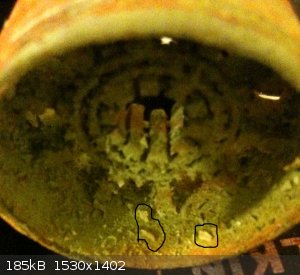wg48
National Hazard
   
Posts: 821
Registered: 21-11-2015
Member Is Offline
Mood: No Mood
|
|
unknown crystals
I left some metal items (steel and copper mostly) in dilute HCl and Forgot about them for months. I recently removed the corroded copper item shown
below. It was partly covered in a layer of crystals with what looked like a very light green color similar to ferrous sulphate however they where not
removed by washing or boiling in water. Three of the largest crystals (about 2mm in length) are identified with loops.
When first removed from the acid the item was a red colored. It has since corroded to some extent to the dirty green colour shown in the picture.
I don't recall precisely what I put in the acid, it was probably metal so the crystals can only be made from metal, HCl, water and air. There is a
vague possibility of a high alumina ceramic was put in the acid too.
Given I am not certain what was put in the acid. I apologise in advance for this daft/impossible to answer question.
Can any one suggest what the crystals may be?

|
|
|
Metacelsus
International Hazard
    
Posts: 2539
Registered: 26-12-2012
Location: Boston, MA
Member Is Offline
Mood: Double, double, toil and trouble
|
|
Copper oxychloride, perhaps?
|
|
|
Dmishin
Harmless

Posts: 32
Registered: 5-10-2015
Member Is Offline
Mood: No Mood
|
|
Could it be metallic copper? Try washing them in HCl.
|
|
|
wg48
National Hazard
   
Posts: 821
Registered: 21-11-2015
Member Is Offline
Mood: No Mood
|
|
The copper oxychloride I have seen is usually a distinct green precipitate. Thinking about it, perhaps as a large crystal it has a very different
color. It certainly has a suitable composition and it may account for the small amount of red precipitate (which I assumed was Cu but perhaps it was
Cu2O) that was produced when I boiled the item to dissolve the crystals which they failed to do significantly.
I will now remove the crystals and try to determine what they are.
|
|
|
Boffis
International Hazard
    
Posts: 1867
Registered: 1-5-2011
Member Is Offline
Mood: No Mood
|
|
In the presence of a trace or air or other oxidizing agent cuprous chloride crystals form. Ammonium chloride reacts similarly with copper. The cuprous
chloride crystals are white or very pale yellow when fresh but rapidly turn green on exposure to air and eventually crumble to a dust of a cupric
oxychloride +/-water (many such compounds are known particularly in nature).
|
|
|
wg48
National Hazard
   
Posts: 821
Registered: 21-11-2015
Member Is Offline
Mood: No Mood
|
|
Quote: Originally posted by Boffis  | | In the presence of a trace or air or other oxidizing agent cuprous chloride crystals form. Ammonium chloride reacts similarly with copper. The cuprous
chloride crystals are white or very pale yellow when fresh but rapidly turn green on exposure to air and eventually crumble to a dust of a cupric
oxychloride +/-water (many such compounds are known particularly in nature). |
I think your probably correct.
That would account for of the colour of the clean crystals,
the probable copper precipitate when the item was boiled
and the green corrosion that formed in air after the item had been washed several times ie the Cu(I)Cl turning to the green oxychloride.
I have only ever seen Cu(I)Cl as a very fine white precipitate perhaps that's why I did not think of it.
|
|
|
wg48
National Hazard
   
Posts: 821
Registered: 21-11-2015
Member Is Offline
Mood: No Mood
|
|
I got round to testing the crystals.
I removed about 50mg from the copper item.
The fresh surfaces do not look like copper.
I added them to dilute sulphuric acid and warmed the mixture. The solution developed a slight blue colour and the crystals did not dissolve but became
white.
I then added them to 32% HCl and warmed the mixture. The solution went dark brown almost black though most of the crystals remained.
I added some of the brown solution to ammonia solution it produced a white precipitate that appeared not to dissolve in excess though I am not certain
the ammonia was in excess as I did not test the pH
When I added sodium per carbonate initially more precipitate formed with fizzing then dissolved turning a clear royal blue.
I think the tests and initial compounds are consistent with the crystal being Cu(I)Cl. Boffis was correct.
|
|
|